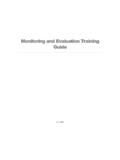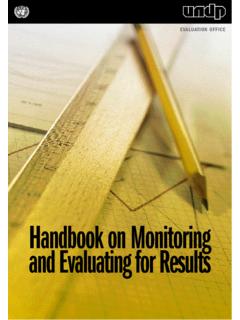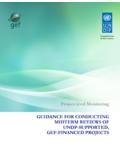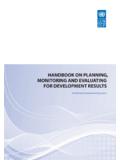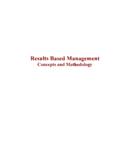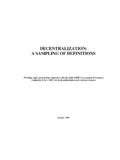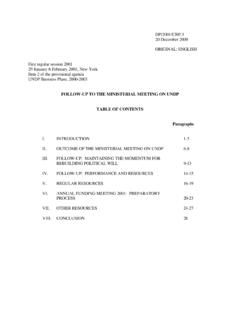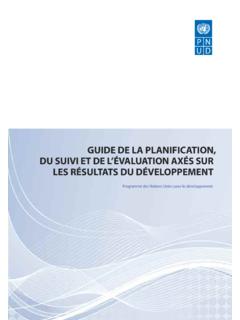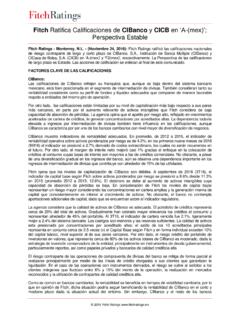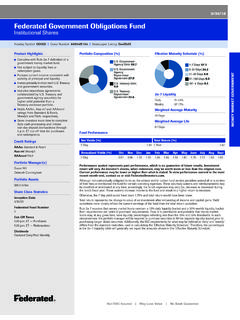Transcription of Chapter 2 COUNTRY CONTEXT - UNDP
1 GEOGRAPHIC AND POLITICAL CONTEXTR wanda is a landlocked COUNTRY in the GreatLakes region of central Africa covering roughly25,000 square kilometers of land and 1,400square kilometers of s population was estimated at slightlymore than 9 million people in mid 2006. Thecurrent population growth rate is estimated at per year while the population density isthe highest in Africa, at 350 people per squarekilometer,3and more than 450 people per squarekilometer of arable political, social and economic CONTEXT ofRwanda is profoundly affected by the civil war ofthe early 1990s and genocide of 1994 and thecountry continues to deal with the considering demographic trends, issuesof land ownership or penal-code reform, thebackground of devastation and horror impingeson the consciousness of all concerned. Even 13years after the genocide, there is an unspokenassumption often underlying discussions of thenation s future to the effect that Rwanda cannotbe considered an ordinary transitional government of national unity established after the genocide of 1994 tookextensive crisis prevention measures in the spiritof never again.
2 It introduced fundamentalchanges that would open doors for reconciliationand help the COUNTRY to move forward and builda new nation whose citizens could live inharmony and COUNTRY adopted a multiparty system, whichhas continued since the 2003 presidential andparliamentary elections. The Rwandan PatrioticFront is the ruling party. It was an importantactor in the political discourse throughout thetransitional period and has continued to play thisrole since the 2003 presidential and parliamentaryelections. These elections marked the conclusionof the nine-year transition to open party politicalactivity at all levels. While Rwanda has maderemarkable progress in the democratic process,the process could mature further through theempowering of political parties, civil society andthe private has gone through many positivedevelopments despite its turbulent history. Forexample,women have entered Rwanda s politicaland administrative institutions in impressivepercentages.
3 They now occupy half the seats inthe National Assembly and almost one third ofthe portfolios in the new peace and stability is an issue of majorconcern to the GoR and its partners. Rwanda liesat the centre of a very densely populated regionthat encompasses Rwanda,Burundi,the Kivuregion of the eastern Congo and area shares very similar languages,a common culture and a long history of socio-economic and politico-military s stability is intimately linked with thestability of this broader region and 2. COUNTRY CONTEXT3 Chapter 2 COUNTRY CONTEXT 3 UNDP, Turning Vision 2020 into Reality: From Recovery to Sustainable Human Development. National HumanDevelopment Report ,Kigali, States Agency for International Development, Rwanda Democracy and Governance Assessment , Office ofDemocracy and Governance, November ECONOMIC SITUATION RECOVERY AND TRENDSR wanda s economy is agrarian. Agricultureemploys almost 80 percent of the population,5accounting for more than 40 percent of grossdomestic product (GDP) and more than 70percent of from unexploited gasreserves beneath Lake Kivu, Rwanda is poorlyendowed with mineral resources.
4 Subsistencefood production is the dominant activity in theagriculture sector. Production of coffee and teafor export is still service sector contributes approximately 39percent of GDP and employs roughly percentof the working population. Within this sector,wholesale and retail trade as well as publicadministration account for approximately 50percent of services. The economic contribution oftourism, while growing rapidly, remains industrial sector makes up 20 percent of theGDP and employs slightly less than 2 percent ofthe working population. Manufacturing constitutesthe most important source of industrial activity,accounting for almost 12 percent of GDP whileconstruction accounts for another 8 percentage of Rwandans living in povertyhas decreased from percent in 2000-2001 percent in 2005-2006. As a result of thecountry s high population growth rate, thisprogress has been overshadowed by an increase inthe absolute number of people living in poverty,increasing from million to million personsduring the same period.
5 Poverty in Rwanda ismainly a rural phenomenon: while the popula-tion is 83 percent rural, 92 percent of the poorlive in rural areas. There are also significantinequalities within and between rural SOUND MACROECONOMIC INDICATORSR wanda s economic growth was rapid in the yearsfollowing the genocide, largely due to determinedeconomic policy, the catch-up effect (due to startingfrom a very low baseline in 1994) and relativelyhigh aid flows. Economic growth has been moremodest in recent years. For 2007, the GoRforecast for GDP growth is percent (Table 1).Fitch Ratings has assigned a B foreign currencyrating to Rwanda with a Positive to Fitch Ratings, Rwanda s rating issupported by a good track record of macroeco-nomic management and reforms, and the receiptof substantial bilateral and multilateral debt reliefin 2005 and TRADE ISSUESD espite an increase in goods exports in the lasttwo years, Rwanda struggles with a chronic have risen sharply since 2004,largely as result of the increasing costs ofimported fuel and energy.
6 The GoR is activelyseeking ways to increase domestic energyproduction, such as exploitation of methanedeposits of the Lake strong market-oriented policies, Rwanda seconomy is not yet well integrated into regionaland global markets. Its landlocked position,deficient infrastructure and small domesticmarket with limited purchasing power have heldback foreign direct investments. At the sametime, a strong national currency, buoyed by thehigh level of development assistance, hasfavoured imports and discouraged economic statistics do not fully recordtrade by the informal sector, which constitutes asignificant proportion of economic activity inCHAPTER 2. COUNTRY CONTEXT5 UNDP, Turning Vision 2020 into Reality: From Recovery to Sustainable Human Development. National HumanDevelopment Report , Kigali, Intelligence Unit, Rwanda COUNTRY Profile 2006 , London, England, Institute of Statistics Rwanda, Preliminary Poverty Update Report, Integrated Living Conditions Survey2005/06 ,(Enqu te Int grale sur les Conditions de Vie des M nages), December , Republic of Rwanda , 19 December 2006, available online at 2.
7 COUNTRY CONTEXT5 Rwanda. It is particularly significant in regionsadjacent to the Democratic Republic of theCongo and Burundi, where Rwanda has animportant trade surplus in both goods andservices. Other positive signs include imports ofcapital goods in last two years that have grownfaster than imports of consumption hope is placed on the integration into theEast African Community, which was planned forcompletion in 2007. While the GoR admits thatadjustment to competition from the largereconomies of Kenya, Tanzania and Uganda willbe challenging, it is convinced that long-termgains will outweigh the INVESTMENT NEEDSR wanda s ambitious economic policy goals implyvast investments in economic and socialinfrastructure, as stipulated in their Long-termInvestment Framework/Portfolio (see Table 2)and the Long-term Investment Framework/Portfoliodocument points out, securing financing is one of the COUNTRY s biggest (million) GDP (Rwf billion)(USD million) , , , , , , , , , , , , GDP (Rwf billion)(USD million) , , , , , , , , , GDP growth (% annual change) GDP percapita (USD) inflation (% annual change) of goods (USD million) of goods (USD million) accountbalance(USD million)(% of GDP, including Official Transfers) economic dataSources: Population Census 2002 via JF Financial Model (MINECOFIN).
8 GDP 2000-2006 NIS, 2007 MINECOFIN estimate; PriceInflation NISR CPI; Exports, imports and current account balance BNR10 Government of Rwanda, Rwanda: A Long Term Investment Framework , Kigali, February 2. COUNTRY CONTEXT6development assistance, which ranges from $400million to $500 million annually, currently coversmore than half of the GoR s budget and most oftheir capital investment budget. Debt relief hasbeen received through the Heavily Indebted PoorCountries Initiative, fiscal performance hasimproved and the share of grant aid in Rwanda soverall Official Development Assistance is expectedto increase. But these sources alone cannot coverinvestment requirements in the coming with a higher targeted level of revenuemobilization, the annual resource gap to meet theMillennium Development Goals (MDGs) wouldaverage approximately $1,000 million during theperiod 2009 to SITUATION INDICATORS AND TRENDSThe legacy of the 1994 genocide and the armedconflict that preceded it continue to weigh heavilyon the social and economic recovery of the events impoverished Rwandans and increasedtheir vulnerability, particularly among the widowsand orphans of the genocide, recently returnedrefugees, resettled internally displaced personsand the families of detained suspects of genociderelated crimes.
9 These problems, combined withvery high rural population densities and smallfarm sizes, have left many Rwandan communitiesunable to provide adequately for their poorestand most vulnerable people, such as women-headed andchild-headed households,are generally at greaterrisk of being poor than other groups. Almost 25 percent of Rwandan households were headedby women in 2006 and percent were headedby encouraging decline in povertyrates has been registered, however, in householdsthat are headed by women, from 66 percent in2001 to 60 percent in HEALTHH ealth care infrastructure was badly damagedduring the early 1990s. It has since been rebuiltalthough the health status of Rwandans remainspoor. Mental health problems, due largely to thehorrors of the genocide and its aftermath, areprevalent in a society that is not equipped to dealwith these problems. Preventable diseases likeHIV/AIDS and malaria remain a burden onRwandan economy both in terms of direct coststo the poor and vulnerable households and interms of loss of labour and labour key indicators from the health sector arestill 2000 and 2005,under-fivemortality decreased from 196 per 1,000 births to152 per 1,000, recovering to pre-war child born into a poor (bottom quintile) familyhas a one in five chance of dying before reachingthe age of five twice as high as for a child borninto a rich (top quintile) family.
10 Malaria hasbecome the leading cause of morbidity andmortality in Rwanda and children under the ageof five account for 35 percent of all malariarelated deaths. HIV prevalence among women inKigali is percent, meaning that a womanliving in Kigali is eight times more likely to getinfected with HIV as a man living in thenorthern National Institute of Statistics of Rwanda, Millennium Development Goals: Towards Sustainable Social and EconomicGrowth , National Institute of Statistics of Rwanda, Kigali, UNDP, Turning Vision 2020 into Reality: from Recovery to Sustainable Human Development. National HumanDevelopment Report , Kigali, , millions2705206906004702,550 Source: Government of Rwanda, Rwanda: A Long-term Investment Framework , Kigali, Rwanda, 2 August requirements of Long-term Investment Framework/Plan (2006-2010) Chapter 2. COUNTRY CONTEXT7 Table 3 reflects Rwanda s health indicatorscompared to other countries in the region.
